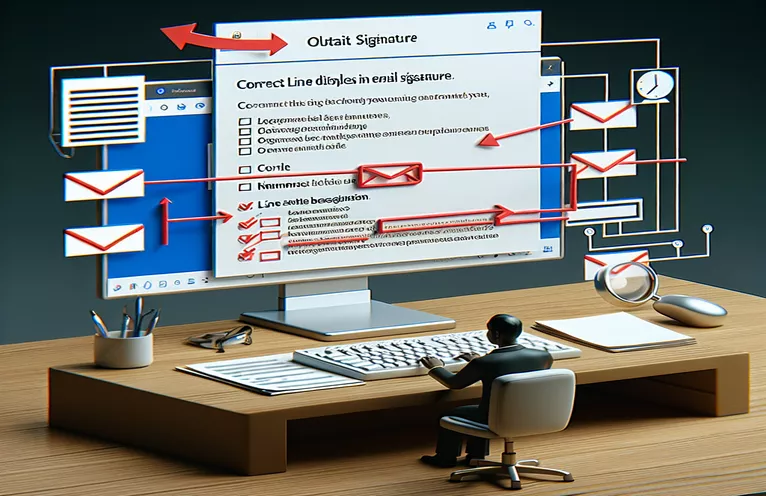Understanding Outlook Email Signature Challenges
Particularly in work environments, email signatures have grown to be an essential component of our online selves. They not only convey essential contact information but also reflect the individual's or the organization's brand identity. But creating these signatures in Outlook can also present unforeseen difficulties, especially when incorporating social icons. The main problem that many users have is that these icons have unsightly lines underneath them, which detracts from the email signature's overall polished look.
The main cause of this issue is usually the disparities in how different email clients render HTML and CSS, with Outlook being especially picky. To create simple, eye-catching email signatures, developers and designers must grasp the subtleties of Outlook's rendering engine. Through an exploration of these problems, this introduction seeks to provide you with the necessary expertise to maneuver through the complexities of HTML email signature design in Outlook, so that your signatures always look clean and businesslike.
| Command | Description |
|---|---|
| CSS Inline Style | Added straight to an HTML element, styles are used to eliminate spaces beneath icons or images. |
| HTML <img> Tag | Used to include social media symbols or other images as an embed in the email signature. |
| Outlook Conditional Comments | Comments designed specifically for Microsoft Outlook should only apply styles or HTML elements when the email is viewed in Outlook. |
Removing Outlook's Social Icon Lines
HTML & CSS for Email Signatures
<!--[if gte mso 9]><style type="text/css">.socialIcon {border: 0;display: inline-block;}</style><![endif]--><a href="your-social-link" style="border: none; text-decoration: none;"><img class="socialIcon" src="your-social-icon-link" style="border: none; text-decoration: none;" /></a>
Perspectives on Outlook Email Signature Creation
Because of the peculiar way Outlook handles HTML and CSS, creating a successful email signature in Outlook requires a deep understanding of these languages. Unwanted lines under social network symbols are one frequent problem that can take away from the professional image of the signature. The Outlook default settings that add underlines to links are frequently the source of this issue. This feature can be useful for differentiating text links within an email body, but it doesn't work well for picture links, like the social icon links in signatures. It's imperative to override these default settings by explicitly designing the links and photos within the HTML code of the email signature in order to guarantee a tidy, professional appearance.
Additionally, Outlook's rendering engine is very different from other email clients' and web browsers', resulting in inconsistent presentation of email signatures. This can be especially difficult to do when creating signatures that appear excellent on all devices. Developers and designers must utilize particular CSS styles and HTML elements to manage how links and images look in order to solve these problems. Unwanted lines can be avoided, for instance, by using inline CSS to eliminate text-decoration and borders from pictures and links. To apply these styles specifically for Outlook and guarantee that the email signature retains its intended form in various viewing environments, you can also make use of Microsoft's conditional comments in the HTML.
Examining Fixes for Outlook Email Signature Problems
Outlook email signatures can sometimes provide special difficulties, especially when social media icons or other visual components are used. These components are essential for improving the visual appeal of the signature and for offering instant access to social media sites. But because email clients show HTML and CSS differently, something that appears flawless in one client may have extra lines or misalignments when viewed in another, like Outlook. The main cause of this disparity is that Outlook uses the rendering engine from Microsoft Word for HTML emails, which interprets CSS differently than other email clients and web browsers.
It's crucial to comprehend the unique characteristics of Outlook's rendering engine and use focused remedies in order to lessen these problems. For example, you can assist avoid underlines from appearing beneath symbols by controlling the design of pictures and links using inline CSS. Furthermore, conditional comments customized for Outlook can guarantee that modifications only impact emails seen in this client, maintaining the intended design on other platforms. These kinds of tactics are essential for preserving a polished and unified brand identity in email correspondence.
Frequently Asked Questions about Outlook Email Signature Design
- Why do Outlook email signatures include lines beneath the social media icons?
- Outlook styles links by default to include underlining pictures enclosed in anchor tags, which causes lines to appear.
- How can I get rid of the lines that appear behind Outlook signature icons?
- Use inline CSS to apply "border: none;" and "text-decoration: none;" directly to the tag and its parent tag.
- Does Outlook disregard any specific CSS styles?
- Indeed, Outlook might disregard certain CSS styles—like background graphics applied via CSS—that Word's rendering engine does not allow.
- Can I use third-party CSS stylesheets to create email signatures in Outlook?
- Since Outlook does not fully support external or embedded CSS stylesheets, it is recommended to use inline styles.
- How may conditional comments be used to customize Outlook email signatures?
- Conditional comments have the ability to target Outlook in particular, enabling modifications that won't impact the appearance of the signature in other email clients.
- Is it feasible to create an email signature that appears the same in all email clients?
- Even if it's difficult, it is achievable with a lot of testing, inline CSS, and conditional comments for Outlook-specific customizations.
- How can I make sure my Outlook social icons are crisp?
- To avoid scaling problems, use high-resolution photos and specify the width and height properties.
- How can I best test the appearance of my email signature in Outlook?
- Send test emails to accounts that can be accessed via Outlook.com and the desktop software, among other versions.
Concluding Remarks on Improving Outlook Email Signatures
A chance to leave a lasting impression on receivers, email signatures are an essential part of professional communication. The difficulties in designing aesthetically pleasing signatures in Outlook, particularly with social icons included, emphasize how crucial it is to comprehend the nuances of email client representation. Through the implementation of focused solutions, such as conditional comments tailored to Outlook and inline CSS, users may get beyond these challenges and guarantee that their email signatures appear polished and official on all platforms. The secret to success ultimately comes in careful testing and adjusting to Outlook's rendering constraints, making sure that the finished signature not only fulfills but beyond expectations in terms of functionality and design. This strategy makes the most of email signatures as a branding and communication tool while also improving the professional image of the person or business.


